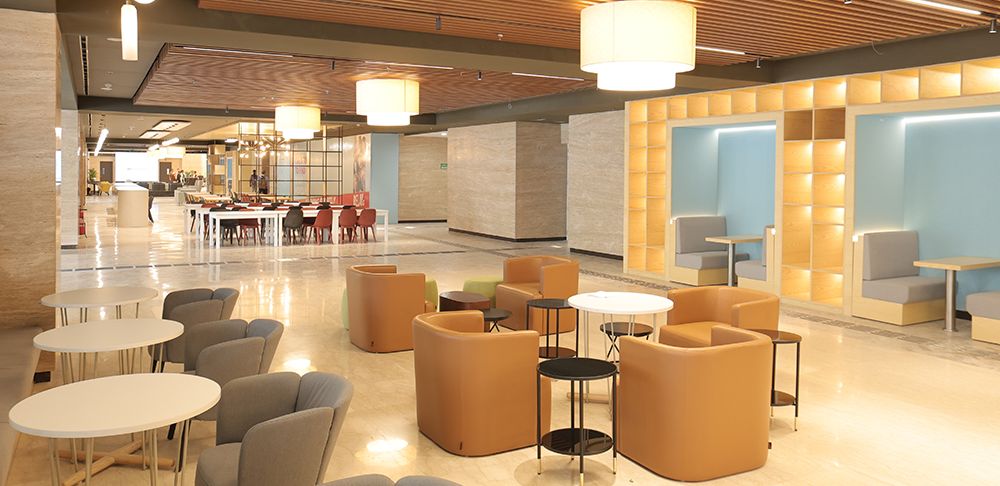-
 1211
1211 - Posted in June, 2025
Quiet Zones vs. Collaborative Spaces: Finding the Right Balance in Modern Offices

Introduction
The modern workplace is evolving rapidly. Traditional cubicle-based office setups are being replaced by modern designs that prioritise flexibility and enhance productivity. Employees today require more than just a desk, and they need workspaces that cater to both focused tasks and dynamic teamwork. This transformation has increased the importance of balancing work environments, ensuring there are spaces for individual concentration and collaborative engagement.
Quiet zones in offices offer employees the calm they need for deep work. On the flip side, collaborative office spaces encourage brainstorming, communication, and innovation. Striking the right balance between the two can enhance productivity in workplaces and improve employee satisfaction.
DLF Offices understands this evolution deeply. Their smart designs integrate focus areas in workplaces with interactive team spaces. This blog explores quiet zones and team collaboration zones. Each serves a different purpose, yet they complement each other. We’ll also see how DLF Offices create ideal activity-based workspaces that support both.
Understanding Quiet Zones in Offices
Quiet zones in offices are purpose-built for tasks that require intense focus and zero distractions. These aren't just secluded desks, but they are immersive, low-noise environments designed to reduce interruptions. In open-plan settings, office privacy solutions like soundproof booths, acoustic walls, and visual barriers make these areas truly effective.
These zones often feature calming interiors, controlled lighting, and policies that limit phone use. Employees who need to write, code, or analyse data rely on these focus areas in workplaces for uninterrupted productivity.
Quiet spaces are especially beneficial in open-plan office layouts, where distractions are common. By including quiet zones, businesses can accommodate different work styles and enhance overall performance.
The Role of Collaborative Office Spaces
While quiet spaces support solo productivity, collaborative office spaces power innovation and teamwork. These areas are essential in fostering a strong office culture and supporting group tasks. Think of them as the engine rooms of creativity, where teams gather to brainstorm, co-create, and problem-solve.
Such team collaboration zones may include open lounges, huddle rooms, and breakout corners equipped with whiteboards and digital tools. These areas reduce formal barriers and promote spontaneous discussions.
Well-designed collaborative office spaces improve communication, quicken decision-making, and build team spirit. They also allow organisations to adapt to dynamic work requirements, making them a key component of flexible workspace design.
Finding the Right Balance: Office Space Planning for Hybrid Needs
Balancing quiet and collaborative areas is central to effective office space planning. A space overloaded with collaborative zones can be chaotic. Too many quiet zones, and it feels disconnected. A hybrid, flexible workspace design merges the best of both worlds.
Office layout strategies play a key role here. Designers need to zone workspaces intelligently, placing quiet zones away from busy corridors and integrating soundproof barriers between high-activity and low-activity zones. Tools like acoustic panels and movable walls help transition spaces based on changing team needs.
Modern offices increasingly benefit from smart technologies. Many occupiers now use AI-powered booking systems to optimise meeting room usage, manage occupancy, and personalise workspace settings. These tools allow employees to seamlessly switch between focused work and team collaboration by reserving the right zones as needed—enhancing both productivity and space efficiency..
How DLF Offices Champion Activity-Based Working Environments
Certainly! Here's a refined version that aligns with your positioning:
DLF Offices offer built-to-suit space solutions tailored to the evolving needs of modern businesses. Tenants can design and implement activity-based working environments that support a range of work styles from deep focus to dynamic collaboration.
Our campuses support this flexibility by enabling layouts with quiet zones, acoustic pods, private booths, and collaborative lounges. Thoughtful spatial planning, intuitive circulation, and acoustic optimisation ensure smooth transitions between different work modes—all designed to enhance user experience and workplace efficiency.
DLF also prioritises employee well-being in offices. Natural lighting, ergonomic seating, greenery, and wellness areas are standard features. This approach not only boosts comfort but also enhances performance.
The Future of Modern Office Design
As hybrid work continues to gain traction, modern office design must evolve. Offices are no longer static, but they’re fluid, responsive, and increasingly people-focused.
We’re moving toward smart offices where AI customises environments, lighting adapts to your mood, and digital assistants find the best space for your next task. In this landscape, balancing work environments remains crucial.
The future also places emphasis on employee well-being in offices. Natural materials, wellness zones, and biophilic designs are becoming standard. The goal is simple: create a workplace that supports the whole person, mind and body.
Conclusion
The workplace of the future must support both deep work and dynamic collaboration. Quiet zones in offices are key to focus, while collaborative office spaces drive engagement and innovation. The synergy between the two fuels productivity in workplaces.
DLF Offices show how this can be done through smart office space planning, user-first office layout strategies, and an unwavering focus on employee well-being in offices. Their approach to flexible workspace design sets a benchmark for modern businesses.
Whether you're working solo or sparking ideas with your team, the right office space makes all the difference. It’s time to rethink your space and design a workplace that adapts, inspires, and truly works for your people.
Ready to create your ideal office? Let employee needs shape your design decisions.
A balance ensures that employees have quiet areas for focus and collaborative zones for teamwork, improving productivity and workplace satisfaction.
DLF Offices integrate soundproof pods, dedicated silent rooms, and ergonomically designed seating to promote focus and reduce distractions.
Collaborative spaces include open meeting lounges, brainstorming areas, and flexible seating that encourage interaction and innovation.
Yes, collaborative office zones boost idea-sharing and teamwork, but when balanced with quiet spaces, they prevent employee burnout.
By combining quiet work zones, collaborative hubs, and hybrid-friendly layouts, DLF Offices deliver workplaces suited for diverse employee needs.
